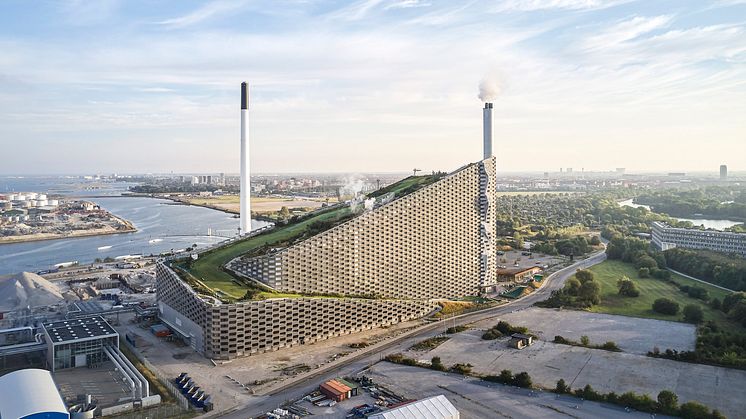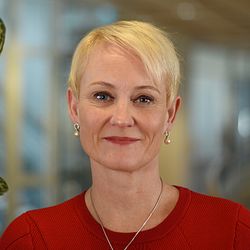
News -
CO₂ capture – To make Copenhagen carbon neutral by the year 2025
500,000 tonnes of CO₂ will be removed from the atmosphere annually, which will significantly contribute to Copenhagen’s goal of becoming the world’s first carbon neutral capital by 2025. These are the goals of a new CO₂ capture facility at Amager Bakke, where CMP is an integral part of the joint efforts with Amager Resource Centre (ARC) – a project based on smart technology, close cooperation, and the desire to make a difference for the climate.
Climate change is making the headlines, daily. Reducing CO₂ emissions to the atmosphere is one of the most important efforts to reverse these changes. Together with ARC, CMP runs a project called “ClimAid,” whose purpose is to capture and store large amounts of CO₂.
“ClimAid is precisely the kind of project we would like to work with and additionally is one that shows what we as a company stand for. These joint efforts with CO₂ capture made with Amager Resource Centre are part of what we call Ocean Valley, where CMP’s goal is to establish an ecosystem for innovative green maritime solutions in the Oresund region,” observes Emil Nordström, Sales Director, Energy & Bulk, who runs the project within CMP.
Capture and Storage
Specifically, it deals with capturing some 500,000 tonnes of the CO₂ currently emitted via the chimneys of ARC’s waste-to-energy plant in Copenhagen. After the capture, the CO₂ is transformed into liquid form and transported in pipelines to CMP’s terminal on nearby Prøvestenen. From here it is pumped over to tankships, which take the CO₂ out further, for example into the North Sea where it will be stored in empty oil fields under the seabed. In technical language this is referred to as Carbon Capture and Storage (“CCS”) and there are many similar projects underway all over the world.
“We are specialists in logistics and will contribute with expertise in transport, storage, shipping and other stages in the handling of carbon,” comments Emil. CMP’s geographical location in the Oresund region is another strength. After the loading on Prøvestenen, the vessels are close to the North Sea and other areas where in the future CO₂ may be stored.
The Municipality of Copenhagen has the ambitious goal of becoming the first CO₂ neutral capital in the world. At the same time there is a national target of reducing Denmark’s overall CO₂ emissions by 70 per cent by year 2030. Amager Resource Centre has unique possibilities to contribute to the achievement of the goals via the ClimAid project.
“It is vital that we have partnered up with such a strong partner as CMP in order to bring this project to life contributing to make Copenhagen the world’s first climate neutral capital by 2025,” says Jacob H. Simonsen, CEO, ARC.
Presently, the plant receives waste from hundreds of thousands of people and tens of thousands of businesses. Approximately 450,000 tonnes of waste are incinerated and recovered as energy in the form of electricity and district heating for households in the surrounding area. The waste incineration results in ARC emitting 560,000 tonnes of CO₂ per year. Via the ClimAid project, 90-95 per cent of these emissions will be captured.
Large-scale operations in 2025
In order make the initiative a reality, new investments are needed and at the moment, ARC and CMP are working to secure financing for these. Out of 311 projects from throughout the EU, ARC’s and CMP’s innovation project has been selected to be among the 70 project finalists that on 23 June 2021 will be sending in a main application to the EU’s Innovation Fund for funding. The target is to obtain approx. DKK 1 billion in support. Besides, additional funding from the Danish state is a prerequisite for the project. The funds will be used to construct and operate the facility that is needed for the CO₂ capture at ARC to be possible. First, the construction of a small demonstration plant will be built, scheduled for completion by 2023, which will capture and convert 12 tonnes of CO₂ each day. A large-scale facility will then be built, which will be operational in 2025, and will thus contribute significantly to making Copenhagen the first CO₂ neutral capital that same year.
“Besides bringing an important contribution to the green transition, this project could create green local jobs and an infrastructure to handle captured CO₂ in Greater Copenhagen. It is therefore vital to establish the right regulatory framework and the sufficient funding in close dialogue with our owners and the Danish Parliament,” comments Jacob.
Investments will also be made at Prøvestenen in preparation for the start-up of the CO₂ capture, including the expansion of pipelines and staging facilities. For almost 100 years, the area has been a hub in the storage and management of essential goods which are used in the Copenhagen region, everything from fuels to building materials. The proximity to the metropolitan region has always been an advantage, but Prøvestenen from time to time has been associated with petrol/gasoline, aviation fuels and other environmentally damaging products.
“What we do together with Amager Resource Centre will thus be the beginning of a transformation of Prøvestenen, sometimes regarded as the “black petrol island” now becomes an island for green energy,” notes Emil.
He explains that the collaborative project takes aim not only at Carbon Capture and Storage, but also at what is known as Carbon Capture and Utilisation (CCU). Instead, one makes good use of the CO₂ captured and uses it as a raw material in new contexts, so it is a form of recycling.
“For example, CO₂ from ARC can be used to develop synthetic fuels as part of what is referred to as “Power-to-X,” which via electrolysis quickly converts green electricity into hydrogen or hydrogen-based fuels for, for instance, the transport sector, including shipping and aviation, which today primarily uses fossil fuels.”
By merging the projects together, Prøvestenen and CMP have an opportunity to position the port of the future as a hub for green development, where CCUS, PtX and other links to various sectors go hand in hand and are fully in line with what we are looking to achieve with Ocean Valley – the synergy for a greener future.
Consistent with the Sustainable Development Goals
Last, but not the least, this type of joint effort contributes to achieving CMP’s own sustainability goals, which also include the UN’s SDGs. One example is SDG 17 “Partnerships for the Goals,” which directly relates to what ARC and CMP will achieve together.
“And by reducing CO₂ emissions so much, we are contributing to achieving SDG 9, which deals with ”Industry, Innovation and Infrastructure” and to SDG 13, which focuses on “Climate Action,” Emil points out.
This article is part of CMP's annual report for 2020. The full report can be found here -->
